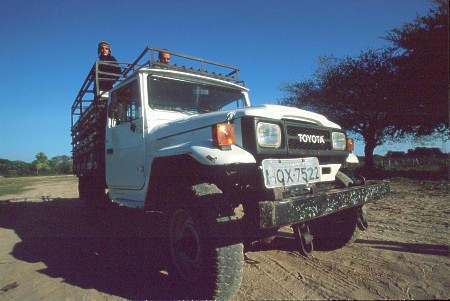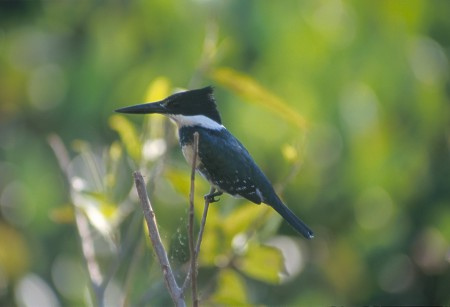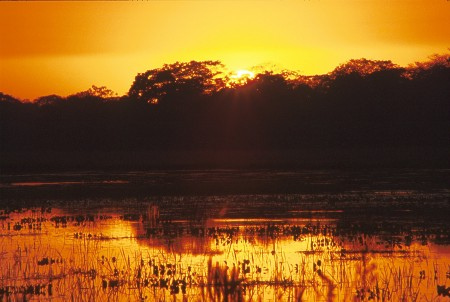The Pantanal Environment
Although the name Pantanal derives from the Portuguese word pântano (swamp), the name is misleading – the Pantanal is really a mixture of several different eco-systems.
Plant and animal life is influenced by the Amazon in Brazil's north, but shares traits with the high tablelands of the Cerrado (in nearby Mato Grosso and Goias states), and dry scrubland known as Caatinga in Brazil or Chaco in Bolivia/Paraguay.
The Pantanal isn’t continuously wet. Instead, it’s a mixture of grassland, scrub, marshes and forest which are subject to seasonal inundations. By contrast, in the dry season, the landscape is vastly different and can become tinder dry, with large areas being consumed by fire. Some of these fires occur naturally, but a larger number result from agricultural burn-offs that get out of control. This fire season is at its worst from September to November, when the air is thick with smoke and particulates, causing respiratory problems for local residents.
Protection of the Pantanal wetlands is important to the well-being and sustainability of central-west Brazil and surrounding territories in Paraguay and Bolivia. It's fate is also linked to that of the Cerrado and the Brazilian tablelands to the north, since these are the origin for the region’s waters. Being located in the geographic centre of the South American continent, the Pantanal is subject to continental extremes with temperatures exceeding 45˚C in summer (which coincides with the wet season). Without plentiful rain, and associated floodwaters, these temperatures would potentially lead to the drying out and gradual desertification of the region. Such an outcome is a possibility if developments occur which interfere with waterways and water sources, divert water for horticulture (e.g. soy beans), or drain the wetlands.
Unfortunately, such developments are frequently proposed by Brazil’s business and agricultural sectors under the guise of providing a short-term boost for the region’s economy – and which require constant vigilance from environmentalists to challenge and fight.
Wetlands are widely recognised for their role softening the impact of heavy rains and floodwaters, serving as a natural filter systems to remove silt and contaminants. Slowing the floodwaters also reduces erosion, and helps recharge the ground water and lakes needed to carry the region through the dry season. Another important function of the wetlands is their role providing a nursery for many commercially important fish species. The wet season, November to March, corresponds with the spawning period known locally as piracema (an indigenous term: pira = fish, cema = jump). This is when fish swim upriver, often jumping up small waterfalls and rapids, returning to their breeding locations to lay their eggs. Commercial and recreational fishing are restricted during this period so the spawning fish can reach their destination, and ensure future stocks.
During this wet season, rivers can rise by as much as five metres. This means that, for several months, ocean-going ships and barge convoys starting in Buenos Aires can enter Rio de la Plata, then into the Paraná River, and navigate up along the Paraguay River as far a Cuiaba at the furthest northern reaches of the Pantanal. One proposal, called Hidrovia, aimed to facilitate this traffic year-round by straightening and dredging the Paraguay River to make it deeper. The overall aim of this proposal was to reduce freight costs for soy beans corn, oil and mining ore from around $90 per ton to $50 per ton (or less).
However, since the Paraguay River provides the Pantanal’s only drainage – this development would have significantly changed the hydrology of the region. A larger and faster-draining river would mean a much drier environment, also diminishing natural ground water and lakes. Additionally, the concentration of waters into a single faster-flowing channel would also create dangers to population centres when the river was in flood – leading to a need for expensive (and not always effective) flood control measures. Although Hidrovia has been put on hold (for the moment) it hasn't been officially cancelled. It will likely resurrected as part of a new Brazil/China investment deal announced in 2015 - and aimed at delivering cheaper iron ore and soy to the Chinese market.
There are also other proposals to create dams for “cheap” hydroelectric energy to help power Brazil’s growing economy, which would similarly impact the region’s hydrology and threaten to dry out the region. These, combined with more intensive agricultural development for soy and increased cattle herd sizes are big concerns.
Florida’s Everglades provide a comparative lesson of the danger of developing wetland environments without truly understanding the consequences. After more than a century draining and developing the wetlands, Florida found its natural environment and water quality deteriorating, with significant property damage and loss of life resulting from storms and floods which even their extensive flood control systems (costing billions) had been unable to cope with. Eventually, past development and the attempts to control nature were seen as a mistake – and the natural role of the wetlands were recognised, utilising its strengths as buffer for storms and floods, and water purification. This led to the Comprehensive Everglades Restoration Plan (CERP) resulting in the demolition major structures, filling in old drainage and flood control canals – and the aim of restoring many wetland areas to their pre-development state. This work is continuing but is slow and considerably expensive for the state. Hopefully, Brazil’s government and planners can learn from Florida’s experience, and avoid making the same very costly mistakes.
Multimedia Links








Photo Credits: Giant Otter (iStock/Torsten Karock)
Bandeirante, Sunset, and Kingfisher (Andrew Mercer)
Pantanal Escapes